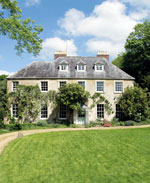Country house confidence
Confidence is creeping back into the country-house market, so now is the time to snap up a bargain before the feeling catches on


The country-house market is currently suspended in a logjam. Since the start of the year, the number of people registering their interest and viewing properties has shot up (COUNTRY LIFE, February 25), and a buying appetite has returned. However, the number of properties being launched witness to this is the advertising pages of this magazine is still much repressed. The result is that buyers are left to go hungry and potential vendors as well as headlines remain downbeat about the market prospects.
One of the unique aspects of what we refer to as ‘the COUNTRY LIFE market’ is that it is largely unaffected by the vagaries of the mortgage markets; instead, it’s mainly governed by good feeling. ‘It’s much more of a confidence rather than finance-based market’ agrees Crispin Holborow, head of Savills’ country-house department. Henry Holland-Hibbert of Strutt & Parker goes further: ‘Purchasers’ nerves have been shredded by the events of last year, notably last September. The prime sector is intricately linked to the banking sector not because all the buyers are bankers, but because they’re businessmen and are likely to have share portfolios that have suffered.’
Having said that, there’s a gathering sense of confidence in the air that could suggest a change of season is on its way. Savills took a page in COUNTRY LIFE last week to highlight that they’d already sold more than 140 country properties this year, and Worcestershire agents Andrew Grant report that buyer activity is now back at September 2007 levels. David Bedford, of East Anglian agency Bedfords, has 50 years’ experience in the business and believes that now is a crucial time for country-house buyers. ‘I think there’s a small window to pick up a good deal this spring, and in a few years’ time, people will look back and say “I wish we’d bought in 2009”.’
A common bleat among agents is the dire lack of houses actually coming on the market. At the top end of the market, there are fewer distressed sales than you might think, and the chances that the market slips so much further that opportunist companies begin to take charabancs of buyers around the countryside on repossession tours, à la Las Vegas, are slim. ‘Surprisingly, the reduction in interest rates, which was meant to kick-start the market, has done quite the opposite,’ says Ian Hepburn, who runs Strutt & Parker Private Search. ‘Before Christmas, we were sensing that some vendors were reaching their limit. However, once the Bank of England brought interest rates down to 1%, it gave them breathing room and allowed them to sit tight.’ Last week, a further 0.5% was shaved off; however, speculation about how long rates will remain this low may result in more stock coming onto the market.
Toby Milbank of Knight Frank is also convinced that there are some good deals to be done, albeit under certain conditions. ‘If a buyer can identify a realistic vendor one who’s priced his house sensibly as a result of the market then there’s an opportunity to buy a good house for not a lot of money.’ The key question is one of timing. Savills’ Lucian Cook believes that we’re seeing the first signs that the rate of price falls will slow, ‘reflecting the increase in applicant numbers, particularly among cash buyers looking to do well at the bottom of the market’. However, he stops some way short of saying it’s the bottom of the market, citing the underlying outlook for the economy. ‘It’s more likely that we’re looking at the beginning of the end of price falls, which will be a progressive process over the next six months or so.’
The most oft-quoted saying among the agents right now is that ‘no one sounds the bell at the bottom of the market’, but timing a buy within 5% of the bottom is a shrewd move. Now could be that moment for two reasons. ‘If you can find a house now, when we’re near the bottom, you’re in a position of strength, with fewer buyers competing, but if you wait until we’re the other side of the curve, then there’ll be 20 people muscling in,’ says Dawn Carritt of Jackson-Stops. ‘And, now that we’re in reporting season for banks and the results aren’t rosy, can you think of a better time that vendors would be amenable to an offer below the asking price?’ asks Mr Holborow.
More movement is coming from the sector that sold their houses at the top of the market and parked the cash in a bank in the hope that the interest would cover the costs of renting until the market cooled. With interest rates evaporating, that choice of finance has run dry. ‘Knight Frank are getting more people who were renting country houses and are now deciding to buy. As a rule of thumb, you pay 3% of the capital value of the property in rent, and now that you can fix a mortgage at 4% for the next 10 to 15 years, it isn’t a big leap,’ says Mr Milbank.
Exquisite houses, the beauty of Nature, and how to get the most from your life, straight to your inbox.
The one sector of buyers for whom this is undoubtedly the best time to buy a country house in years is those paying with foreign currencies. Anyone with Euros is managing to shave 45% off the peak value in some cases. ‘And they’ve definitely noticed it,’ says Alex Newall at Knight Frank, who deals with the £10-million-plus sector. ‘The market is now far more affordable to international buyers than it has been for a long time. Many see this as an opportunity not to be missed.’ So, although the bells might not exactly be tolling, the shackles on the market look to be coming off.
